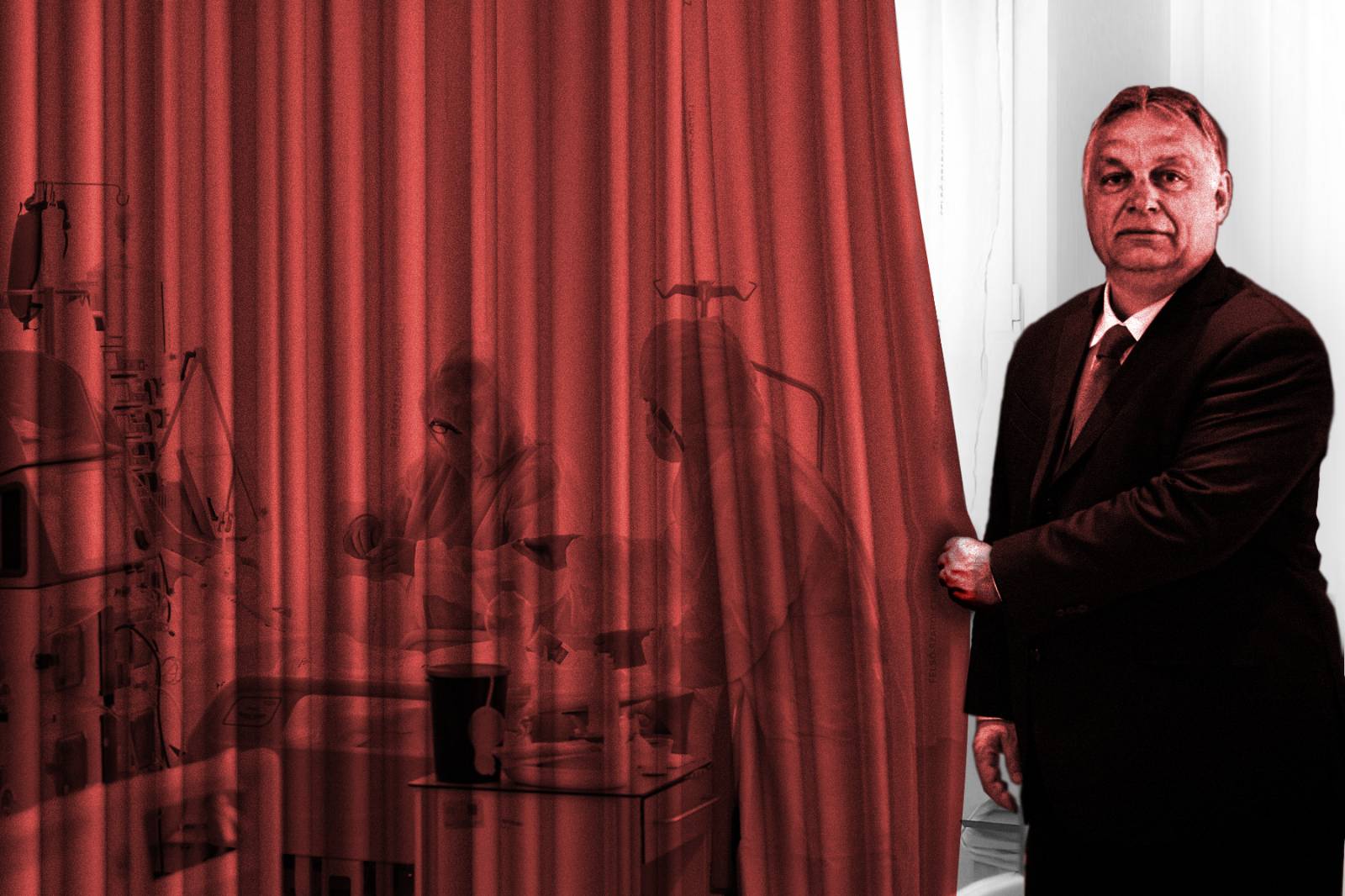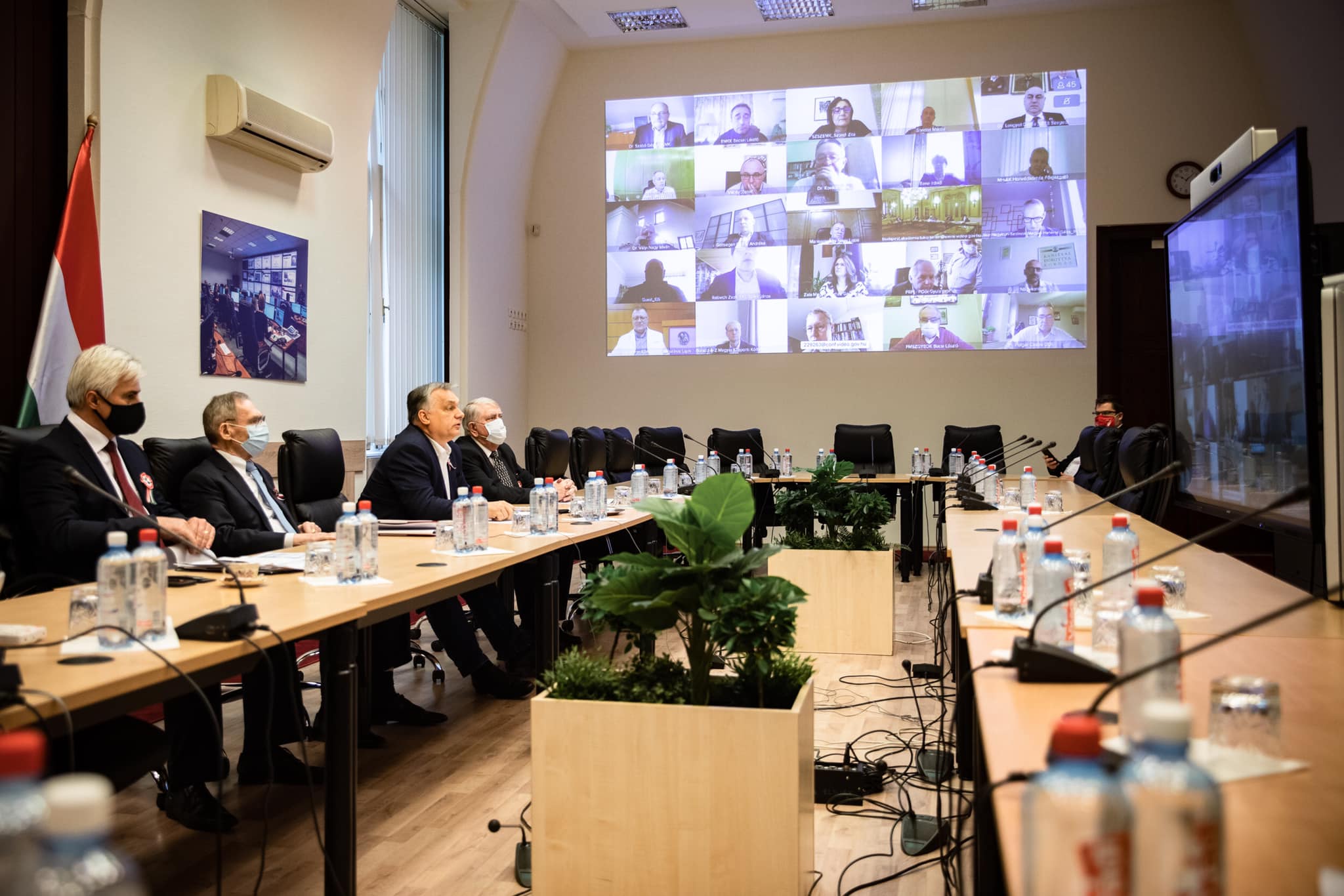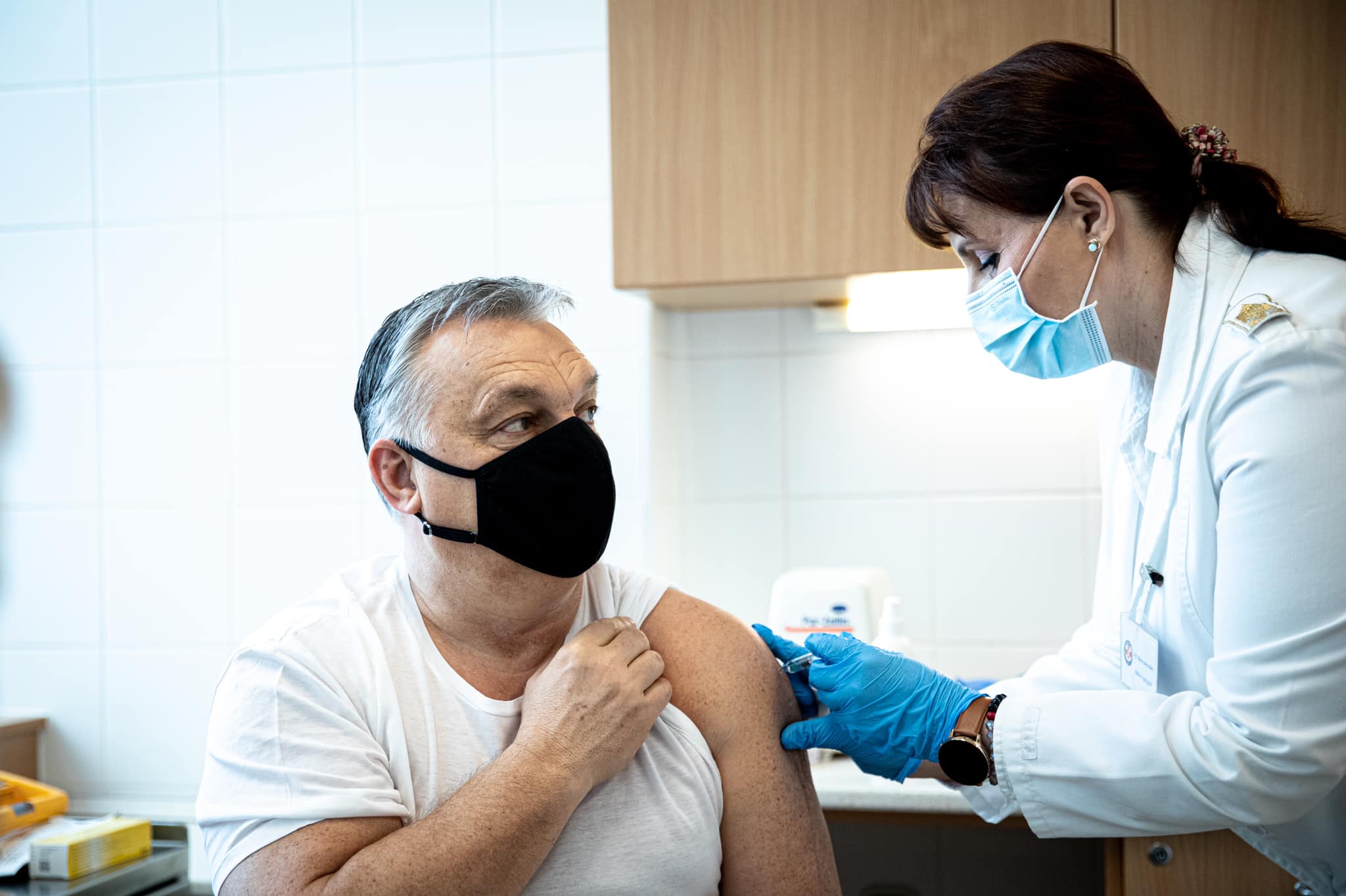PM Orbán tried to prevent hospital dramas with vaccination. In the end, he could only hide them

In April, during Hungary’s most devastating month of the coronavirus epidemic, something unusual happened in a cultural center in Székesfehérvár, an hour’s drive from Budapest: László Bucsi, the director of the local hospital, standing in front of cameras with a microphone in his hand, began to speak with surprising honesty about the severity of the epidemic.
Bucsi started by saying that although the ministry always asks hospital directors not to talk about specific numbers, he decided to do so, nonetheless. “In our intensive care unit, of those who are put on a ventilator, 84 percent never get off. They die, 84 out of 100 people die,” Bucsi said, then added: “It had never happened in the history of Hungary that crematoria worked three shifts. It’s tragic and people just don’t know about it.”
With these sentences, Bucsi deliberately broke an agreement. He was only allowed to give an interview with the condition that he doesn’t talk about specific numbers. Still, the hospital director decided to speak out as he thought the vast majority of people were still unaware of what the real situation was.
Bucsi’s decision had consequences. A few days later, Interior Minister Sándor Pintér gave an online briefing to hospital directors, and he said plainly at the end: Doctor Bucsi should see him at a personal meeting in Budapest next week. Pintér signaled to the other hospital directors that whoever spoke out would get in trouble. When he questioned Bucsi at their meeting, the minister even wanted to know if it was the hospital director himself who decided to break the deal, or somebody else gave him permission to do so.
This is one of the episodes that illustrate the amount of effort the Hungarian government put into withholding meaningful information about the health care system during the third wave of the epidemic. When case numbers significantly increased in the spring, there was an internal debate among Fidesz politicians about whether to show to the public what was happening inside the hospitals, according to Direkt36’s information. Some thought that such reports could have helped people to accept the importance of restrictive measures and vaccination. However, presenting the situation also carried political risks, and it was important for the government that people did not lose faith in the ability of Hungary’s health care system to handle the situation.
In the end, the government did everything to prevent any information coming out from hospitals, run by militant rigor. Yet by this time, real dramas were unfolding in healthcare institutions. Sources from hospitals told Direkt36 that, due to capacity problems in hospitals – both on the countryside and in the capital – patients over 60-70 years of age did not even have a chance of being put on ventilators.
The third wave of the coronavirus epidemic – unfolding during the spring of 2021 – was the deadliest one in Hungary. Although it became clear by mid-February that the spread of the British variant would cause serious problems, the government only announced the first restrictive measures, the closure of schools and shops, in early March. Decisions were postponed because the government was confident that the vaccination program could help to avoid the third wave without restrictions, government sources told Direkt36. Moreover, the government did not want to go against the opinion of the public, which supported re-opening even in February, as surveys conducted by the government showed.

Orbán Viktor kórházigazgatókkal egyeztet 2021. március 14-én – Fotó: Orbán Viktor / Facebook
By the end of March, the number of Hungarian victims of the epidemic was one of the highest worldwide, relative to population. However, the government deliberately avoided talking about the victims, and also managed to prevent information leaking to the public about controversies surrounding the delayed introduction of restrictive measures and about dramatic conditions in hospitals. Instead, the government emphasized the success of the vaccination program that, despite some initial problems, gained momentum in March and was rolling out faster than in other EU member states, thanks to an abundance of eastern vaccines. All this resulted in political gains: in April, most pollsters measured increased popularity of the ruling Fidesz party.
Direkt36 spoke to more than a dozen sources – hospital workers, government actors and opposition politicians in contact with them – in order to understand the background of the measures taken during the third wave of the pandemic. Due to the sensitivity of the topic, sourced spoke to Direkt36 on condition of anonymity.
We sent several questions about the measures taken to the government, the Operative Body responsible for handling the coronavirus and to Fidesz, but nobody replied. The director of the Székesfehérvár hospital, László Bucsi, did not want to comment either. In our previous articles, we had already shown the political background of epidemic management in Hungary during the first and second waves of the coronavirus.
They thought that vaccination would solve everything
Already during second wave of the epidemic last fall, the government put its faith in a new weapon that would soon be available: vaccination.
“Vaccines will be the new mask,” essential for combatting the epidemic, but it is possible that there would be a shortage of vaccines – according to a government source, Foreign Minister Péter Szijjártó realized this early on. His thinking was quickly adopted by the government because, according to the source, it was believed that “if there was a shortage of resources again, that could even result in the fall of the government.” This was the reason why, although last autumn even Viktor Orbán supported the European Commission’s strategy of joint vaccine procurement, the Hungarian government decided in October to buy more vaccines separately from other markets as well. As in the case of previous COVID-related purchases, the government’s attention turned yet again eastward and started negotiations with Russia and China.
However, there was a problem with Eastern vaccines: people had less confidence in them – according to a government source, this was shown by their own surveys conducted at the end of last year. Orbán wanted to increase trust by stating in January that he would be vaccinated with Chinese vaccine. Later, the vaccine approval process was also simplified, and contracts were signed for the purchase of Russia’s Sputnik and then China’s Sinopharm vaccines. The government’s commitment to Eastern vaccines further increased when, in late January, it became clear that deliveries from Pfizer and AstraZeneca pharmaceutical companies were slower than expected.

Orbán Viktort a kínai Sinopharmmal oltották be – Fotó: Orbán Viktor / Facebook
Although the more contagious British variant of the virus appeared in Hungary in mid-January, and the number of infections began to rise again in February, the government – trusting its own vaccine procurement program – had not yet been thinking of introducing any restrictive measures. At that time, only 3-4 percent of the population was vaccinated, but the government was confident that vaccination would quickly pick up speed. “If we vaccinate quickly and if we can purchase even more vaccines, the good effects will outweigh the bad effects,” the prime minister said in a radio interview on February 12. In mid-February, the government even launched a national consultation campaign on “issues regarding reopening.”
“Everyone was confident that the third wave would not be as severe as the second was,” a Fidesz politician told Direkt36, adding that the government hoped the third wave would be mild or possibly even non-existent thanks to the vaccinations.
However, the just-launched vaccination program could not prevent the third wave from exploding. Within a few days, on February 18, Chief Medical Officer Cecília Müller said that the second wave had not even ended, but the third one had already begun. And, on February 25, Orbán also used a dramatic tone in a video: “I only have bad news. The situation seems to be that (…) we are facing the most difficult two weeks of the whole epidemic so far. Due to the emergence of new types of mutations, the number of infections in increasing, and will continue to increase significantly. There will be a burden on our hospitals like never before.”
Although more and more people were warned about the severity of the epidemic, it took two more weeks following Müller’s announcement about the third wave until the government introduced restrictive measures. “It is the luxury of epidemiologists that they only have to pay attention to the epidemic itself,” a government source explained the reasons for the delayed action. According to the source, the government had to take into account not only epidemiological, but also economic and political considerations.
Already during the second wave of the virus, fears of an economic downturn prompted the government to introduce restrictive measures as late as possible. This was a decisive consideration also in February, although a Fidesz source explained this to Direkt36 by saying that the government wanted to avoid putting too much burden on families with school closures again.
Political considerations played a role in the government’s close attention to public sentiment. “At the beginning of the third wave, people didn’t really want to accept that there would be another round,” said a Fidesz politician, adding that decisions were adjusted to the public mood, which was constantly measured by the government, to avoid social tensions. Another Fidesz politician said they wanted to avoid cases like the one in Germany where, at the end of August last year, people tried to attack the German parliament, the Reichstag, protesting against restrictive measures. According to the politician, the government has successfully avoided more serious social dissatisfaction. “In our case, the tension was limited to Facebook and, at most, protests of hundred people,” the source said.
According to the government’s surveys, public sentiment has also changed as the number of COVID patients increased. In mid-February, when Müller announced the start of the third wave, 4,021 were in hospital and 332 were on a ventilator. Two weeks later, by early March, the number of COVID patients in hospitals had risen to 6,554 and those on ventilator to 639.
By this time, the government felt it had enough support for the introduction of restrictive measures. In addition, they also listened to epidemiologists who, relying on mathematical models, calculated when it was needed to take actions in order to maintain the health care system’s ability to take care of patients. Considering these, the government decided to announce restrictive measures on March 4: the closure of schools and certain shops, as well as the use of masks in public spaces.
Although a Fidesz politician now told Direkt36 that schools should have been closed as early as February, back then there was no one within the government who urged earlier closures. “The defense against the coronavirus was led by Orbán, it would have been high treason if someone had come up with an independent alternative” against him, a government source told Direkt36.
The situation was further complicated by the fact that at the start of the third wave, healthcare workers were preoccupied not only with the epidemic but also with the uncertainty of their own future. According to a legislation, doctors and nurses working in public health care had to sign their new contracts by 1 March. Although the law has increased the salaries of most doctors, it also caused tensions as it made it difficult for them to take on second jobs. Because of this, thousands have not signed the contract. Dealing with this situation has also placed a heavy burden on hospital management, which is why, as a source working in healthcare put it, “they weren’t prepared for health care nearly collapsing within weeks.”
They wanted to keep secret what was going on in hospitals
The “most difficult two weeks” predicted by Orbán at the end of February lasted longer than expected: in his radio interviews in mid- and late March, the PM said that Hungarians were still experiencing the hardest weeks of the epidemic. Meanwhile, both the number of people treated in hospitals and those on ventilators grew, the third wave approaching its peak.
According to Direkt36’s sources, politicians from the governing Fidesz party internally raised the questions of “why don’t we show what is happening in hospitals.” According to a Fidesz politician, this was often the topic of controversy during personal conversations when they met with colleagues at events and “there was criticism directed towards the center.” Some argued that if the struggle in hospitals was shown to the public, it could convince more people of the importance of restrictive measures and vaccination. Others argued that the reality is not as awful as many imagine, so journalists should be allowed to report from hospitals.
In the end, however, the government decided to completely seal off hospitals from the public, for several reasons. On the one hand, due to political risks, they wanted to avoid reports in the evening news about the state of healthcare and the burden on the hospitals. “The point was that people should not lose faith that Hungarian healthcare was able handle the situation,” said a Fidesz source, adding that they did not want to “scare people too much.” The government also feared that in case a hospital has a more critical situation, it would be overdramatized by the media, and later it would be more difficult to ban journalists from hospitals.
Although the government had already significantly restricted the flow of information during previous epidemics, this was taken much more seriously in the spring than before. Since the beginning of the epidemic, hospitals have been managed by Minister of Interior Sándor Pintér, who has maintained a strict order. This helped to restrict the flow of information from hospitals, according to a government source. “We will not win a war while talking about the unpreparedness of the army,” the source explained the military logic introduced in the hospitals, which was incompatible with journalistic reports about the burden on hospitals. In the end, during the third wave, there was not even a single recording leaking from a COVID department that would have caused uncomfortable moments for the government.
It was also strictly forbidden for hospital staff to talk to journalists about the conditions at their workplace. A source working in the management of a hospital in Budapest put it this way: “regulations regarding communication have been dusted off everywhere.” As an example, the source mentioned that, at the peak of the third wave, a worker of Semmelweis University (one of the more actively communicating hospitals) was reproached after posting pictures of themselves in protective gear on Facebook.

Hospital directors were also afraid of breaching communication regulations, as Pintér maintained strict order against them throughout the epidemic. A source from a hospital described the military discipline with a scene that took place last year: when the newly appointed hospital managers first met Pintér, before the arrival of the minister, an aide told hospital directors that they should “stand up while waiting for the minister and only sit down once the minister had already taken his seat”, adding that the directors should not ask any questions and only speak when they are asked to.
As a result, little was known about what was actually happening in the hospitals, although from mid-March, the situation became serious in several institutions. According to a senior doctor at a rural hospital, the number of serious COVID-19 patients treated in their hospital was three times higher during the third wave of the epidemic than during the second wave. Thus, the entire institution was designated to handle this situation. According to the doctor, one of the most serious problems was that even though they had a certain number of beds in the COVID intensive care unit, only half of the beds were suitable to operate with a ventilator. Even though they had plenty of ventilators, they simply didn’t have enough people to operate the machines.
Because of this, doctors faced very difficult decisions. “At the height of the epidemic, there were days when people over the age of 60 didn’t have much of a chance to get on a ventilator,” a doctor told Direkt36, who also experienced this situation personally. He was once on duty when a 70-year-old patient’s condition worsened, and he would have needed mechanical ventilation. “I called the intensive care unit where they said that, unfortunately, there was no way to do that now,” the doctor said. According to the source, no consilium was convened in these cases, instead, the patient’s caregiver referred to the head of the intensive care unit who was on duty, who decided whether or not to admit the patient.
“Elderly chief doctors were going home with tears in their eyes, because they had spent almost the entire day declaring the death of patients,” the source described the period that put a huge burden on healthcare workers.
According to doctors who talked to Direkt36, it happened both in Budapest and in rural hospitals that patients had to be ranked. Although considering the chances of patients and the benefits of their treatment are among the responsibilities of doctors under normal circumstances as well, at the height of the pandemic, sometimes extreme situations unfolded in the overburdened intensive care units. A hospital source told a story about this: a psychiatrist was on duty in a COVID ward, who saw that the condition of several patients was deteriorating to the point where they needed intensive care. However, when he called the intensive care unit, the head of the department asked the psychiatrist, “in whom do you see perspective?” The issue put the psychiatrist in a difficult position, who – because of the lack of specialized training and proper guidance – was not prepared for making such decisions.
During this period, even within the government, which looked confident from the outside, it was feared that the epidemic might become uncontrollable. This concern was also felt in conversations both between pro-government and opposition politicians. An opposition local government politician from Budapest said that when he met his Fidesz colleague for a work meeting during the peak of the epidemic and they started to talk about the virus, the pro-government politician said that “the situation may soon get even worse than it is now.”
The government has officially denied that hospitals face serious problems. In mid-March, Tamás Svéd, Secretary of the Hungarian Medical Chamber told 444.hu news portal that due to the lack of qualified staff, Hungary’s health care system was coming to the end of its capacities. However, Gergely Gulyás, the Minister heading the Prime Minister’s Office, called his statement a lie. At the end of March, the Ministry of Human Resources said that the director of the hospital in Ózd (a town in Northern Hungary) lied when he told the local television: “you should image scenes in Ózd hospital similar to the ones seen last year in Italy.” With this, he was referring to pictures taken in Bergamo, Northern Italy, where even hospital corridors and waiting rooms were filled with COVID patients lying everywhere.
After all this, it did not take the government by surprise when, on 31 March, several media outlets independent from the government issued a joint statement, demanding journalists and cameras to be admitted to the COVID departments of hospitals, in order to show the situation to the public. Government spokesman Zoltán Kovács reacted to this on his Facebook page two hours after the publication of the statement: “Hospitals are there to cure patients, not to accept cameras.” In the evening, Orbán also referred to this when he said in an interview given to public television: “Now it is not the time, for example, to go to hospitals and to make fake videos or fake news, and so on.”
Vaccination campaign and indifference towards the victims
However, this interview was not only a message for journalists. Orbán also said that, in a few days, the number of vaccinated people will reach 2.5 million, and then restrictive measures will be eased. The Hungarian vaccination campaign progressed well compared to other EU member states. Although at the beginning of March, the vaccination of 74 thousand people turned into chaos when several of them received incorrect information via SMS, similar cases did not occur later.
By this time, pro-government politicians – who again seemed more confident – started to accuse opposition politicians of being against vaccination. “The anti-vaccination campaign, sorry to use such a strong term on Good Friday, but it’s a sin. Because those who are discouraged from taking the vaccine may die, and some of those die indeed who listen to the left,” Orbán said at the beginning of April.
The opposition started to criticize the acquisition of unlicensed Eastern vaccines at the end of last year. The pro-government press had already written at the time that the left would like to undermine vaccination for purely political interests. From mid-March, the government started to use its slogan “anti-vaccine left” again, but more intensively than before. “When it seemed that vaccination would be a success story, the government wanted profit from it twice,” according to a government source who said that is was the idea of the communication team led by Antal Rogán and Árpád Habony to put pressure on the opposition with this slogan.
As another response to criticism of Eastern vaccines, pro-government politicians proudly stated in private conversations that, just like Orbán, they also received the Sinopharm vaccine. An opposition MP described a typical scene when he met a Fidesz politician, and after some small talk the topic of the pandemic came up, and the politician said: “You’re stupid to talk against the Chinese vaccine, as for myself, I have already taken it.”
Fidesz politicians did not only direct such words towards the opposition. They also considered the Chinese vaccination as a declaration of allegiance, trusting that they could earn some good points with it in the eyes of the prime minister. “Fidesz is an Orbán-party. If an MP wants to win a mandate as a Fidesz politician in the future, obviously, he must follow Orbán,” a government source said.
For the government, the high vaccination rate was a key factor also because it provided an opportunity to hide the most dramatic impact of the epidemic: by the end of March, the number of Hungarian victims of the epidemic was one of the highest worldwide, relative to population. While the government constantly talked about the vaccination rate — and even adjusted the speed of reopening to the number of vaccinated people – it purposefully avoided mentioning the victims who died of coronavirus.
The opposition tried to steer the attention towards the high mortality rate. They believed that Orbán himself had put the issue into the spotlight last September – when the mortality rate was still low – saying that the success of the epidemic management can be measured by the number of deaths. When the opposition recalled Orbán’s earlier statements, the government fought back by saying it was “not tasteful” to talk about the dead and that the opposition was conducting a “death campaign.”

Public opinion about the government did not change significantly due to the high mortality rate. According to a government source, their own opinion polls for internal use showed that half of the voters felt the government had done everything it could to defeat the epidemic.
“Many people have seen fatalities even among their family member and friends, but society wants to live,” a Fidesz politician explained the mortality rate’s lack of impact on the government’s support. According to a government source, the opposition has not been able to gain politically from this situation because “no good campaign can be built on death.” “It’s too depressing, it didn’t work, just as Fidesz’ slogan from 2006,” when they campaigned against the socialist government in power by saying that “we are worse off than four years ago.” In addition, he said, the government also benefited from the fact that the vaccination campaign was in full swing at the time when the death toll was very high in early April. This has increased the willingness to vaccinate, which, in turn, was beneficial for the government that put all the emphasis on the vaccination.
As a result, compared to February, most pollsters measured the strengthening of Fidesz by a few percentage points by April. Opinion poll data also suggest that the opposition was unable to profit from the initial mistakes of epidemic management. The combined support of all six opposition parties is just around as high as support of Fidesz. “At the peak of the epidemic, we should have led by not one or two percentage points, but by at least fifteen. In addition, as the economy recovers, Fidesz will become even stronger in the coming months,” said an opposition MP, gloomy about their prospects at the upcoming elections next year.



